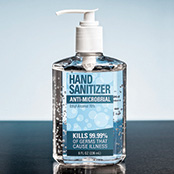 With the COVID-19 pandemic going on, you want to keep your hands as germ-free as possible. But if you regularly reach for hand sanitizer, it pays to know a few key facts. Start with this one: Washing your hands with soap and running water for 20 seconds is typically the best way to clean your hands.
With the COVID-19 pandemic going on, you want to keep your hands as germ-free as possible. But if you regularly reach for hand sanitizer, it pays to know a few key facts. Start with this one: Washing your hands with soap and running water for 20 seconds is typically the best way to clean your hands.
If you can't get to soap and water, a hand sanitizer can be a good choice. Even so, you have to use the right product—in the right way—to get the most out of it.
Here are some good-to-know tips:
1. Do use an alcohol-based hand sanitizer. It should contain at least 60% alcohol. Sanitizers without alcohol may only keep germs from multiplying instead of killing them.
Also, be aware: Even an alcohol-based sanitizer doesn't get rid of all types of germs. Washing with soap and water is better at removing:
• Norovirus, the leading cause of food poisoning.
• Some parasites.
• Clostridium difficile, which causes severe diarrhea.
2. Don't rely on hand sanitizers to remove harmful chemicals. It's unlikely that sanitizers can remove chemicals like pesticides and heavy metals. If you've come in contact with them, wash your hands carefully with soap and water. Or call a poison control center for directions.
3. Do check for dirt. If your hands are dirty or greasy, hand sanitizers may not work well. Stick to handwashing, if possible.
4. Don't rush. Use enough sanitizer to cover all parts of your hands and fingers. Then rub your hands together until they feel dry—that should take about 20 seconds. Hand sanitizers may not be as effective if you rinse or wipe them off before your hands are dry.
5. Do be careful around kids. Keep hand sanitizers out of the reach of young children, who might mistake them for food or candy. In 2020 alone, U.S. poison control centers received nearly 25,000 calls about hand sanitizer exposure in kids 12 and younger. A child who swallows even a small amount of an alcohol-based hand sanitizer could be at risk for alcohol poisoning. That can be deadly in severe cases.
Sources: American Association of Poison Control Centers; Centers for Disease Control and Prevention